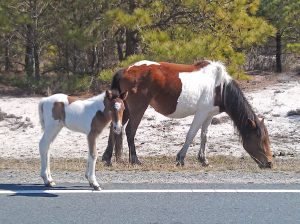
ASSATEAGUE — National Park Service staffers are spending much of November conducting pregnancy tests on many of the mares on the barrier island.
Each November, Assateague Island National Seashore biologists conduct pregnancy tests on the mares among the population of wild horses on the barrier island in an attempt to predict how many if any new foals are expected to join the herd in the coming year. Essentially, staffers follow the mares and wait for them to defecate.
Samples are collected, frozen and sent to a lab to be analyzed to determine if any of the mares will be expecting next spring. There could one or two new foals next spring or as many as five or six, or possibly even zero. For over two decades, Assateague staffers have been monitoring the birthing habits of the island’s most famed residents and the information collected this month, or more specifically the fecal matter, will tell the story for the coming year.
Assateague staffers know each the mares in the herd by their alpha-numeric name, their markings, the bands they belong to and the areas of the island they tend to frequent. Although it is not entirely scientific, the pregnancy tests generally serve as a good barometer for the expected foals in the next year.
It is not infallible, however, and every once in a while, there are surprise births on the island. Assateague Island National Seashore Chief of Interpretation and Education Liz Davis said this week the fecal samples are being collected throughout November.
“The staff just started collecting the samples for pregnancy testing, so we won’t have the results until probably the beginning or middle of December,” she said. “We’re testing all mares ages two to 24.”
In September, a census revealed there are currently 79 wild horses on the Maryland side of Assateague Island including 21 stallions and 58 mares. Three new foals were born last year, but there were also some losses in the population due to vehicle collisions, old age and just attrition. The target rang for the population is 80-100, and at 79, the population has dipped below that number for the first time in recent memory.
Because the population is at or below the threshold of the target range, no mares were darted with contraception last year, meaning all of the 58 mares currently in the herd will be tested for pregnancy this month.
“The pregnancy testing routine doesn’t change with the population size,” said Davis. “The number of mares tested would only change if we had mares contracepted in a given year, since the contracepted mares are not pregnancy-tested. There were no mares contracepted this year, so all will be tested.”
The popular horses on Assateague are wild animals and generally left to the whims of nature. However, in the interest of maintaining a healthy population size, the National Park Service several years ago began a contraceptive program for the mares. In almost each year since, selected mares have been injected, or darted more appropriately, with a non-invasive contraceptive called PZP in an effort to maintain the size of the herd on the Maryland side in its manageable threshold.
After years of trending above the ideal population range, a combination of natural losses, attrition, old age and some accidents has brought the number of wild horses on the barrier island down to the low end. As a result, in recent years National Park Service staffers have moved from a reduction strategy with the contraceptive program to an adaptive management strategy. With no mares contracepted last year, there could be relative baby boom on the island next year and the pregnancy test samples collected this month will predict that.
